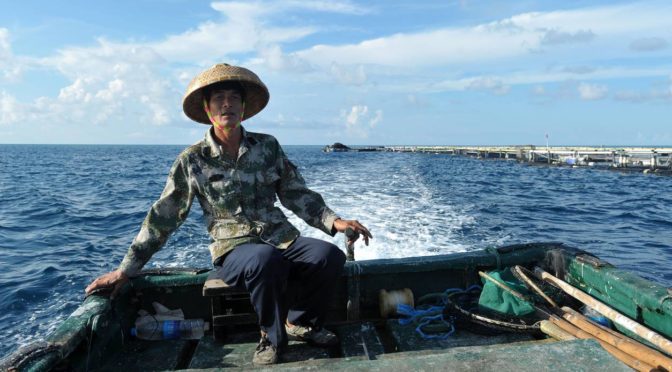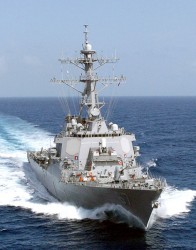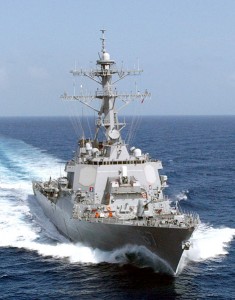By Michael Perry
Introduction
Fish are the primary source of animal protein for populations bordering the South China Sea (SCS) and overfishing in the region has emerged as a major threat to food security.1 Over the past 30 years fish stocks have declined by one-third and are expected to decrease an additional 59 percent by 2045 if current practices persist.2
The threat is recognized by all SCS nations but hasn’t been curtailed for three primary reasons. First, the migratory nature of fish requires all SCS nations to jointly agree on constraints. Disagreements have not only made cooperation difficult, but have led to increasingly frequent confrontations between rival Maritime Law Enforcement (MLE) forces and fishermen. Second, even if nations could agree, the presence of Illegal, Unreported, and Unregulated (IUU) fishing creates an MLE challenge. Lastly, the first two challenges coalesce to form a third – disparities in MLE capabilities affect perceptions of fairness and the perceived benefits of cooperation. That is, a nation asked to carry a heavier MLE burden may demand an increased share of fish stocks.
There may be a solution. U.S. MLE assistance can set the conditions for a fair, fully cooperative fishing agreement among SCS nations with minimal risk of escalating the present situation to the level of war.
Challenges to Cooperation
Fisheries economists agree that when nations cooperate to optimize the use of depletable resources, total catch increases because stocks are maintained at high levels.3 However, economists have also demonstrated that nations deviate from this total catch maximization model because there is no clear way to divide the “cooperative surplus” among nations, defined as the excess catch above what’s attained under noncooperation.4 As a consequence, noncooperation leading to overexploitation has been observed time and again.5 The reasoning behind this is simple. If nations unilaterally pursue policies not agreeable to others, the sum of these policies will exceed the optimal cooperative policy, and stocks will become depleted.
The concept of a fair allocation of the cooperative surplus is particularly challenging in the SCS. Expansive claims based on historical discoveries and interpretations, United Nations-defined exclusive economic zones, and the occupation of islands and reefs afar from mainlands leads to a large degree of overlapping jurisdictions.6 The most extreme claim is that of China’s “nine-dash line,” encompassing 80 percent of the SCS.7 Aside from tangible issues of geography and historical discovery, a nation’s ideology can contribute to what’s perceived as “fair.” China views itself as a Middle Kingdom that ought to govern affairs in its area of the world, if not globally. This conflicts with the U.S. view that it occupies the position of global leadership and must “contain” China from becoming too influential.8 Thus, even if China could make a case that its geography, population, MLE capabilities, and so on, warrant a “fair” allocation encompassing its claimed 80 percent of the SCS, established U.S. policy would be to exert influence to alter this balance, which would enrich other SCS nations to the detriment of China.
Were the challenge of a fair allocation of the cooperative surplus to be solved, SCS nations would still face an MLE challenge as IUU fishing is prevalent in the SCS. The current situation under noncooperation is informative for understanding the extent of IUU fishing. The Southeast Asian Fisheries Development Center, an intergovernmental organization including all SCS nations other than China, estimates IUU fishing currently accounts for 8-16 percent of total catch.9 Much of this is Chinese fishing which China doesn’t consider IUU, but it would be naïve to assume that were China to enter a cooperative agreement that curtails its allowable catch, there would be a corresponding decrease in IUU fishing. A cooperative agreement will place increased constraints on fishing, thus decreasing supply and increasing the incentive to fish illegally. For fishermen suddenly forced out of the legal fishing business, IUU fishing will be a logical, even if risky, line of work. Empirically, past agreements outside the SCS have seen this phenomenon occur.10 Thus, to address the MLE requirements brought by a constrained fishing environment, nations must also engage in security cooperation so MLE effectiveness can be maximized. IUU fishing can only be assumed to decrease following a cooperative agreement if SCS coast guards fully integrate their MLE efforts so there are no weak spots IUU fishermen can exploit.
The final challenge to cooperation is a conglomeration of territorial disputes and IUU fishing, along with China’s supremacy in MLE. China’s coast guard easily surpasses all other SCS nations combined in gross tonnage, with 190,000 tons of coast guard vessels of multiple types.11 In contrast, Vietnam and the Philippines possess 35,000 and 20,000 tons, respectively, while Indonesia possesses about 400 vessels compared to China’s 1,300.12 ISR and aircraft are both force multipliers in MLE and China has superiority in each of these.13 Thus, China possesses great leverage when bargaining over the cooperative surplus.
Presently, noncooperation persists because China has calculated it is better off using its MLE strength to unilaterally impose its own laws in the SCS, rather than submitting to terms acceptable to the other bordering states. This strategy is evident in repeated instances of the Chinese Coast Guard intervening in fishing disputes with Vietnam near the Paracel Islands, with the Philippines near the Scarborough Shoal (approximately 472 NM from the Chinese mainland), and with Indonesia near Natuna (1151 NM).14 The problem with this unilateral Chinese strategy, aside from a lack of fairness, is that it has failed in the sense that overfishing persists. Despite its superiority in MLE, China hasn’t been able to reverse the observable trend of depleting stocks in the SCS.
In light of these issues, while geography and historical claims are immutable sources of conflict, MLE capabilities are mutable and can be employed by the U.S. to mitigate the threat of overfishing in the SCS. By providing MLE assistance to non-Chinese coast guards, the U.S. can, at minimum, assure China’s attempt to unilaterally control the SCS no longer appears feasible, and may even bring about a fully cooperative agreement.
Shaping the Conditions for Cooperation
An important notion from cooperative game theory is that when the right incentive structure is in place, players who would otherwise be in competition will form a “cooperative coalition” that is beneficial to all. The first objective of U.S. MLE assistance in the SCS should be to provide non-Chinese nations sufficient capabilities to police an area of the SCS that can provide a sustainable level of fish to all nations in the coalition. Lacking this, some nations may acquiesce to Chinese unilateralism as the best option. A fully cooperative agreement would include China, whose MLE capabilities would partially offset needed U.S. assistance to combat IUU fishing, and per economic theory total catch will increase as well. While Chinese cooperation can’t be assumed, it is highly desirable and MLE assistance should be directed toward convincing China the coalition can be an ally vice adversary.
While the coast guard figures cited earlier show a clear capabilities advantage for China, it is not an overwhelming one. Consider, for instance, disparities in population and hence demand for fish. Non-Chinese nations account for only 25 percent of the population bordering the SCS, so coalition MLE may only need to control a comparatively small section of it.15 Further, while China does possess superior air and ISR assets than other SCS nations, they still lag the U.S. in these areas.16 Aircraft and ISR are comparatively cheap relative to large end surface vessels. These facts make it seem promising the U.S. can cost-effectively close the MLE capabilities gap; looking at current coast guard and military aid budgets provides a useful heuristic to assess this more fully. China spent approximately $1.7 billion per year from 2011 through 2015 to modernize its coast guard. In contrast, the U.S. currently spends over $10 billion per year on its coast guard, while Vietnam and the Philippines each spend about $200 million.17 U.S. military aid for fiscal year 2019 allocated $30 million, $12 million, and zero dollars to the Philippines, Vietnam, and Indonesia, respectively. The global mission to improve food security was allocated $518 million.18 Active participation by U.S. Coast Guard assets in the SCS has been virtually nonexistent, though in May 2019 they participated in a combined exercise with the Philippines, perhaps signaling willingness by the U.S. to invest more in MLE assistance.19
Given these figures it is clear a relatively small investment in the modernization of regional coast guards could go a long way. While federal budgeting is competitive and slow to change in the U.S., there are strong reasons to justify increased funding for MLE in the SCS. Aside from the general notion throughout the Department of Defense of a shift in emphasis toward INDOPACOM, there is a growing trend towards gray-zone operations where coast guards are better positioned than navies to play the central security role.20 Further, MLE assistance is ultimately intended to induce security cooperation with China to combat IUU fishing; successful cooperation on the comparatively benign issue of overfishing may pay dividends in resolving contentious issues closer to the level of war.
The above analysis makes it appear feasible the U.S. could provide the necessary MLE assistance to cordon off a section of the SCS sufficient to supply sustainable levels of fish to partners, and at a moderate cost. The problem, however, is that due to the migratory nature of fish this cordoned off area must be larger than what a simple calculation of fish per capita would suggest. Fish stocks intentionally left uncaught by the coalition will migrate to waters not policed by the coalition. In an idyllic world China wouldn’t deplete these migratory resources, but realistically overfishing should be expected as China disagrees with the fairness of the coalition’s policy. To account for expected Chinese excesses the coalition’s area must expand, so not only does required MLE assistance increase, but there is a risk of becoming too provocative and causing China to escalate hostilities to the level of conflict. It is therefore critical to assess the likelihoods of China joining an expanding coalition, and alternatively escalating to war.
The rationale for China joining the coalition in the face of U.S. MLE assistance is that, given the strengthened ability of the coalition to defend its waters, China’s strategy of unilaterally imposing its own laws for sustainable fishing will become clearly impractical. Under the current state of affairs China’s strategy isn’t working yet there’s still no sign of a shift, indicating they still believe aggressive unilateralism can work if they further advance their MLE capabilities. By advancing a regional coalition’s MLE toward first-world standards, U.S. partners can impose costs on Chinese unilateralism and hopefully encourage China to see cooperation as the best option. The suboptimality of unilateral MLE on the part of China is, however, not sufficient to assure cooperation. China has a third option, which is to escalate the dispute over fishing to the level of war. Fortunately, there are multiple reasons to believe China won’t take such action.
A comparison to a similar dispute over fishing laws involving China is informative. In the East China Sea (ECS), China and Japan have an ongoing dispute over fishing rights near the Senkaku Islands. While each continues to proclaim ownership of the Senkakus and surrounding waters, there have been far fewer provocative actions by China than seen in the SCS, and zero instances of the Chinese Coast Guard detaining Japanese fishermen.21 The limited hostilities in the ECS are likely the result of Japan fielding a peer coast guard to China’s.22 In fact, far from leading to war over the Senkakus, Japan’s ability to resist Chinese unilateralism led to an agreement between the two nations on both fishing constraints and MLE cooperation, which was signed in 1997.23
Despite the datapoint that Japan’s peer coast guard successfully curtailed Chinese unilateralism in the ECS, there is a justifiable fear that the interactive effects of China being curtailed in both the ECS and SCS would push it over the edge. It may consider failure to control either the SCS or ECS an unacceptable threat to its aim of becoming a global superpower and opt for war rather than cooperation.24
This is, however, unlikely due to the multitude of internal problems China currently faces that hinder its ability to wage a conventional war against U.S. partners. For example, China is facing a workforce crisis where cheap labor, which was the catalyst for its “economic miracle” that began in the late 1970s, is disappearing. Mortality rates, once in decline, are now on the rise in China.25 The United Nations’ Human Development Index for China also lags far behind first-world standards.26 All these factors negatively effect China’s ability to fund a prolonged, large-scale war. China does have escalation dominance over other SCS nations, so to signal to China that war would in fact be “prolonged” and “large-scale,” the U.S. must maintain its strong naval presence in the region as a sign of its commitment to fight a war if necessary.
Conclusion
U.S. MLE assistance in the SCS can mitigate Chinese unilateralism on fishing rights without provoking war, establish sustainable levels of fishing without Chinese cooperation, and may lead to a fully cooperative agreement with China to combat overfishing. Full cooperation has three key advantages, including a greater total catch, a reduced requirement for the U.S. to provide MLE assistance, and a reduction in the threat of war, even if this is small in the noncooperative case. It is therefore in the U.S.’ and partners’ interests to provide fair terms for an agreement with China rather than one that appears exploitative and pursuant of a containment policy. An agreement that is most likely to be accepted is one that has clearly defined rules on who can fish where and how much, how random fluctuations in catches will be remedied through trade, as well as complete transparency in how these determinations are made.
Michael Perry is a PhD student at George Mason University studying applications of game theory in the security environment. He is also a U.S. Navy Reservist and has deployed to Singapore, Bahrain, and Rota, Spain. The views expressed in this article are his own.
References
1. Zhang, “Fisheries Cooperation in the South China Sea: Evaluating the Options.” Marine Policy 89 (February 2018): 67–76. https://doi.org/10.1016/j.marpol.2017.12.014.
2. Hsiao, Amanda. “Opportunities for Fisheries Enforcement Cooperation in the South China Sea.” Marine Policy, June 2019, 103569. https://doi.org/10.1016/j.marpol.2019.103569.
3. Munro, Gordon R. “Game Theory and the Development of Resource Management Policy: The Case of International Fisheries.” Environment and Development Economics 14, no. 1 (February 2009): 7–27. https://doi.org/10.1017/S1355770X08004671.
4. Kaitala, Veijo, and Marko Lindroos. “Sharing the Benefits of Cooperation in High Seas Fisheries: A Characteristic Function Game Approach.” Natural Resource Modeling 11, no. 4 (1998): 275–99.
5. Munro, Gordon R. “Game Theory and the Development of Resource Management Policy: The Case of International Fisheries.” Environment and Development Economics 14, no. 1 (February 2009): 7–27. https://doi.org/10.1017/S1355770X08004671.
6. Stearns, Scott. “Challenging Beijing in the South China Sea.” Voice of America. State of Affairs (blog), July 31, 2012. https://blogs.voanews.com/state-department-news/2012/07/31/challenging-beijing-in-the-south-china-sea/.
7. “Coastguard Here to Help, US Says to South China Sea Nations.” South China Morning Post, July 11, 2019. https://www.scmp.com/news/china/diplomacy/article/3014006/coastguard-here-help-says-us-south-china-sea-nations.
8. Goodman, Melvin. “The Twin Dangers of Exceptionalism and Mindless Bi-Partisanship.” Counter Punch, June 13, 2019. https://www.counterpunch.org/2019/06/13/the-twin-dangers-of-exceptionalism-and-mindless-bi-partisanship/.
9. “Catch Documentation and Traceability.” Southeast Asian Fisheries Development Center, n.d. https://www.seafdec-oceanspartnership.org/catch-documentation-and-traceability/.
10. Zhang, Hongzhou. “Chinese Fishermen in Disputed Waters: Not Quite a ‘People’s War.’” Marine Policy 68 (June 2016): 65–73. https://doi.org/10.1016/j.marpol.2016.02.018.
11. Morris, Lyle J. “Blunt Defenders of Sovereignty – The Rise of Coast Guards in East and Southeast Asia.” Naval War College Review 70, no. 2 (2017): 38.
12. Morris, “KPLP Director Asks for Effective and Efficient Patrol Boat Management.” Berita Trans, May 7, 2018. http://beritatrans.com/2018/05/07/direktur-kplp-minta-pengelolaan-kapal-patroli-efektif-dan-efisien/.
Erickson, Andrew S. “Numbers Matter: China’s Three ‘Navies’ Each Have the World’s Most Ships.” National Interest, February 2018.
13. Morris, “The Era of Coast Guards in the Asia- Pacific Is Upon Us”; Morris, “Blunt Defenders of Sovereignty – The Rise of Coast Guards in East and Southeast Asia.”
14. “Are Maritime Law Enforcement Forces Destabilizing Asia?” ChinaPower: Unpacking the Complexity of China’s Rise, 2019. https://chinapower.csis.org/maritime-forces-destabilizing-asia/.
15. “World Population Prospects.” United Nations, 2019. https://population.un.org/wpp/Download/Standard/Population/.
16. Morris, Lyle J. “Blunt Defenders of Sovereignty – The Rise of Coast Guards in East and Southeast Asia.” Naval War College Review 70, no. 2 (2017): 38.
17.Ibid.
18. “Congressional Budget Justification: Department of State, Foreign Operations, and Related Programs, Fiscal Year 2019.” U.S. Department of State, February 12, 2018.
19. Jennings, Ralph. “Coast Guard Gives US New Tool in Disputed South China Sea.” Voice of America, May 20, 2019. https://www.voanews.com/east-asia/coast-guard-gives-us-new-tool-disputed-south-china-sea.
20. “The Era of Coast Guards in the Asia- Pacific Is Upon Us.” Asia Maritime Transparency Initiative (AMTI), CSIS (March 8, 2017). https://amti.csis.org/era-coast-guards-asia-pacific-upon-us/.
21. Morris, Lyle J. “Blunt Defenders of Sovereignty – The Rise of Coast Guards in East and Southeast Asia.” Naval War College Review 70, no. 2 (2017): 38.
22. Ibid.
23. Hsiao, Amanda. “Opportunities for Fisheries Enforcement Cooperation in the South China Sea.” Marine Policy, June 2019, 103569. https://doi.org/10.1016/j.marpol.2019.103569.
24. Phillips, Tom. “Xi Jinping Heralds ‘new Era’ of Chinese Power at Communist Party Congress.” The Guardian, October 18, 2017. https://www.theguardian.com/world/2017/oct/18/xi-jinping-speech-new-era-chinese-power-party-congress.
25. Chomsky, Noam. “‘Losing’ the World: American Decline in Perspective, Part 1.” Tom Dispatch, February 14, 2012. www.tomdispatch.com/post/175502/tomgram%3A_noam_chomsky%2C_hegemony_and_its_dilemmas/.
26. “Global Human Development Indicators.” United Nations, 2018. http://hdr.undp.org/en/countries.
Featured Image: Fisherman Shi Renping sails a fishing vessel towards a deepwater fish farming base near Meiji Reef of the Nansha Islands of China, July 17, 2016. (Xinhua/Zhao Yingquan)




